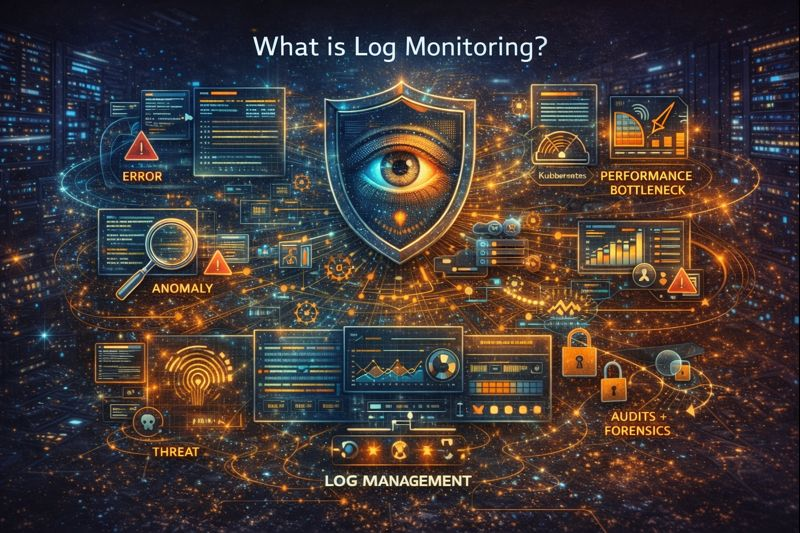Log monitoring tools collect, parse, store, and analyze system and application logs so teams can detect issues, troubleshoot faster, and meet compliance. In 2026, the best options combine real time search, alerts, long term retention, and AI driven insights across cloud, containers, and on prem infrastructure for complete observability and incident response.
Choosing the right log monitoring tools can dramatically reduce MTTR, surface hidden errors, and improve security posture. This in depth guide covers the 11 best log monitoring tools in 2026, how they work, key features to prioritize, and practical steps to implement centralized logging at scale based on 12+ years of hands on server and observability experience.
What is Log Monitoring?
Log monitoring is the continuous collection and analysis of logs from servers, applications, containers, and network devices.

The goal is to detect errors, anomalies, and performance bottlenecks in real time. Modern platforms unify log management, metrics, and traces (observability) while offering dashboards, alerting, correlation, and long term retention for audits and forensics.
How Log Monitoring Works?
Most setups follow a standard pipeline:
- Log shippers (e.g., Filebeat, Fluent Bit, Promtail) collect logs from hosts and containers.
- Ingest layer buffers and routes logs to storage (e.g., Kafka, Logstash, Vector).
- Processing parses, enriches, and normalizes fields (JSON, Grok, pipelines).
- Storage indexes or compresses logs for fast search (Elasticsearch, Loki, ClickHouse).
- Analytics UI provides search, dashboards, alerts, and correlation.
For security use cases, platforms add SIEM capabilities: threat detections, UEBA, and compliance reports. For SRE and DevOps, emphasis is on real time search, query performance, and cost control.
How to Choose the Best Log Monitoring Tool?
Match your needs to these critical criteria:-
- Coverage: Linux/Windows, Kubernetes, serverless, edge, network devices.
- Ingestion & parsing: Native support for JSON, Syslog, CloudTrail, Nginx, MySQL, and custom pipelines.
- Query speed: Performance at TB/day and during incident spikes.
- Alerting & AI: Threshold and anomaly alerts, noise reduction, and root cause hints.
- Retention & compliance: Hot/warm/cold tiers, encryption, RBAC, SOC 2/ISO 27001.
- Costs: Ingest vs. retention vs. queries; predictable pricing and storage control.
- Ecosystem: Integrations with CI/CD, ticketing, SIEM, and APM/metrics.
- Ease of use: Onboarding, templated dashboards, and low learning curve.
Top 11 Best Log Monitoring Tools in 2026
1. Splunk Platform
Splunk remains a powerhouse for enterprise log analytics and security. It offers unparalleled search capabilities, flexible ingestion, and a deep app ecosystem. With strong SIEM and observability tie ins, it suits complex, multi tenant environments.
- Best for: Large enterprises, security operations, regulated industries.
- Standout: Advanced query language, machine learning toolkits, rich RBAC.
- Pros: Mature ecosystem, limitless extensibility.
- Cons: Cost and complexity can be high without careful governance.
2. Elastic Observability
Elastic combines Elasticsearch, Logstash/Beats, and Kibana for full stack logging and metrics. It’s popular for flexible, self managed or cloud deployments and powerful search at scale.
- Best for: Teams wanting open tooling with strong search and dashboards.
- Standout: Schema on read/write, ingest pipelines, Fleet/Elastic Agent.
- Pros: Huge community, versatile deployment models.
- Cons: Cluster management, scaling hot/warm tiers requires expertise.
3. Datadog Log Management
Datadog unifies logs with metrics, traces, and RUM. Its logging features emphasize intelligent sampling, pipelines, and correlation—great for cloud native teams seeking quick wins and strong visualizations.
- Best for: Kubernetes and multi cloud DevOps/Platform teams.
- Standout: Automatic service correlation and watchlists.
- Pros: Fast time to value, excellent UX.
- Cons: Can become pricey at high ingest volumes without retention controls.
4. Grafana Loki
Loki stores logs as compressed streams and indexes labels, making it cost efficient at scale. Paired with Promtail and Grafana, it’s a favorite for Kubernetes and SRE teams.
- Best for: Cost conscious, cloud native logging with Grafana stack.
- Standout: Label based queries, object storage friendly architecture.
- Pros: Lower storage costs; easy correlation with metrics/dashboards.
- Cons: Querying requires good label hygiene; complex retention policies need planning.
5. Graylog
Graylog delivers a strong, user friendly log management solution built on Elasticsearch and MongoDB. It’s known for efficient search, pipelines, and enterprise security modules.
- Best for: Mid-market teams needing control without mega-complexity.
- Standout: Stream-based routing and processing pipelines.
- Pros: Straightforward UI; good alerting and compliance features.
- Cons: Scaling Elasticsearch still requires careful operations.
6. Sumo Logic
Sumo Logic offers cloud-native log analytics and SIEM with strong security analytics, compliance packs, and continuous intelligence dashboards.
- Best for: Cloud-first orgs and security teams.
- Standout: Out-of-the-box content for audits and threat detection.
- Pros: Scales transparently; managed service.
- Cons: Proprietary query language; costs vary with data tiering.
7. New Relic Logs
Part of New Relic’s all-in-one observability, New Relic Logs brings tight correlation with APM and infrastructure data. It’s ideal when you already standardize on New Relic.
- Best for: Full-stack teams using New Relic APM/infra.
- Standout: One UI for logs, traces, and metrics; guided workflows.
- Pros: Fast onboarding; clear service maps.
- Cons: Less flexible than DIY stacks; cost considerations at scale.
8. Mezmo
Mezmo focuses on developer-friendly logging with streamlined ingestion, live tail, and intuitive search. Strong for teams that value simplicity and speed.
- Best for: Startups and product teams moving fast.
- Standout: Live tail and quick setup across Kubernetes and VMs.
- Pros: Clean UX; alerting and retention controls are easy to apply.
- Cons: May lack niche enterprise features or SIEM depth.
9. Sematext Logs
Sematext provides managed log management with integrated monitoring. It balances features and affordability with flexible data shipping and powerful search.
- Best for: SMBs and mid-market seeking price-performance.
- Standout: Unified monitoring + logs; easy shipping with Logsene agent.
- Pros: Transparent pricing; quick wins for smaller teams.
- Cons: Fewer advanced security features vs. SIEM-focused platforms.
10. AWS CloudWatch Logs
For AWS-heavy workloads, CloudWatch Logs offers native ingestion, metrics extraction, and alerting. With Log Insights, you can query logs without managing infrastructure.
- Best for: Pure or primary AWS environments.
- Standout: Tight integration with Lambda, ECS/EKS, ALB, and CloudTrail.
- Pros: Serverless; integrates across AWS services.
- Cons: Cross-cloud visibility limited; cost control needs filters and retention policies.
11. CrowdStrike Falcon LogScale
Falcon LogScale is designed for low-latency ingest and blazing-fast search at massive scale. Strong fit for security and high-throughput observability workloads.
- Best for: High-ingest, low-latency security and SRE use cases.
- Standout: Streaming architecture; rapid queries on recent data.
- Pros: Handles spikes elegantly; efficient compression.
- Cons: Learning curve for query language; enterprise-first positioning.
Quick Comparison: Which One Should You Pick?
- Fastest onboarding: Datadog, Mezmo, New Relic, Sematext
- Lowest storage costs at scale: Grafana Loki
- Best for AWS-only stacks: CloudWatch Logs
- Most flexible open stack: Elastic, Graylog
- Enterprise SIEM depth: Splunk, Sumo Logic, Falcon LogScale
How to Implement Log Monitoring in 7 Steps – Step by Step Guide
- Define goals: Troubleshooting, SLOs, security, compliance, or all.
- Estimate volume: Logs/day, peak throughput, retention months.
- Pick a platform: Map features and costs to your goals and volume.
- Standardize formats: Prefer JSON logs; add request IDs and user/session info.
- Ship logs: Install agents (Filebeat/Fluent Bit/Promtail) with buffers and backoff.
- Set alerts: Start with error rates, latency spikes, auth failures, and 5xx bursts.
- Optimize costs: Drop noisy fields, sample debug logs, tier storage.
# Example: Filebeat to Elasticsearch with JSON parsing
filebeat.inputs:
- type: filestream
id: app-logs
paths:
- /var/log/myapp/*.log
parsers:
- ndjson:
overwrite_keys: true
add_error_key: true
processors:
- add_host_metadata: ~
- add_cloud_metadata: ~
output.elasticsearch:
hosts: ["https://es-prod:9200"]
protocol: "https"
username: "${ES_USER}"
password: "${ES_PASS}"
index: "app-logs-%{+yyyy.MM.dd}"
setup.template.enabled: true
setup.ilm.enabled: true
setup.ilm.rollover_alias: "app-logs"
setup.ilm.pattern: "{now/d}-000001"Real World Use Cases
- Incident response: Query all 5xx errors in the last 15 minutes across Kubernetes pods; correlate to deploy SHA.
- Security monitoring: Trigger alerts on repeated failed logins or unusual admin actions; retain for 1 year for audits.
- Cost optimization: Route noisy debug logs to cold storage; keep only structured fields needed for search.
- Compliance: Generate PCI DSS/ISO 27001 audit trails with role-based access and immutable retention.
Pro Tips from 12+ Years in Hosting and Observability
- Log less, log better: Emit structured JSON with consistent keys; avoid dumping stack traces in hot paths.
- Correlate everything: Add request_id, user_id, and service name to every log line.
- Budget governance: Cap ingestion with processors, sampling, and filter rules before data lands in hot storage.
- Shift-left: Validate log formats in CI and reject malformed events early.
- Runbook it: Convert recurring alerts into runbooks; link dashboards, queries, and remediation steps.
Where YouStable Can Help
As a hosting and cloud partner, YouStable can provision optimized servers for Elastic, Loki, or Graylog, configure secure ingestion (TLS, RBAC), and set up dashboards and alerts tailored to your stack. If you prefer SaaS, we’ll help integrate agents, cut noisy data, and implement retention policies that reduce logging bills—without losing visibility.
FAQ’s
1. What are the best log monitoring tools for Kubernetes in 2026?
Top choices include Grafana Loki with Promtail, Datadog Logs, Elastic Observability, and New Relic Logs. These integrate with Kubernetes metadata, support autoscaling, and correlate logs with metrics and traces for faster root-cause analysis.
2. How do I reduce log monitoring costs without losing insights?
Adopt JSON fields, drop noisy attributes, sample verbose logs, and tier storage (hot/warm/cold). Set retention per index/label, and create route rules to archive low-value logs to object storage.
3. Is open-source logging (ELK, Loki, Graylog) better than SaaS?
Open-source offers control and potential cost savings at scale but requires ops expertise. SaaS platforms speed up deployment, reduce maintenance, and add AI features. Choose based on team skills, compliance, and budget predictability.
4. What’s the difference between log monitoring and SIEM?
Log monitoring focuses on troubleshooting and performance. SIEM adds security detections, threat intel, UEBA, and compliance reporting. Many tools now bridge both, but security teams often need SIEM-grade features and data governance.
5. How much log retention do I need?
For SRE/DevOps, 7–30 days of hot data is typical, with 3–6 months in warm or cold tiers. Security/compliance may require 1–7 years. Implement tiered retention so you keep hot data searchable and archive the rest cost-effectively.

